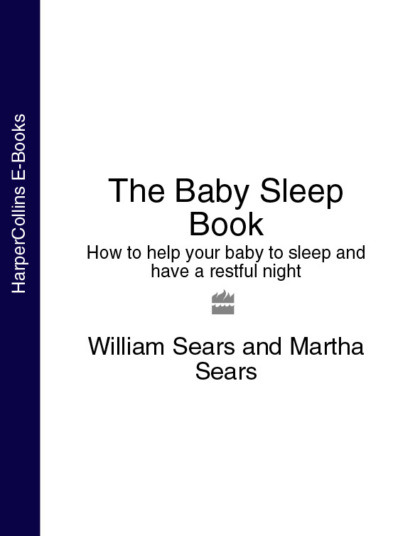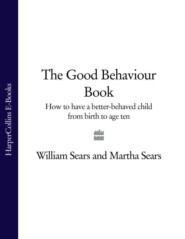По всем вопросам обращайтесь на: info@litportal.ru
(©) 2003-2024.
✖
The Baby Sleep Book: How to help your baby to sleep and have a restful night
Автор
Год написания книги
2018
Настройки чтения
Размер шрифта
Высота строк
Поля
Once baby gets used to sleeping with you, he may not want to give it up. For some of you, this is an advantage because you welcome this long-term bonding arrangement. For others, co-sleeping may go on longer than you would have liked.
You may have enjoyed sharing sleep with your baby, but now one or all of these disadvantages are interfering with your sleep. If your co-sleeping baby is waking up too much, you can choose either to keep baby in your bed and work through the other steps in our plan, or you can look at the other options for where baby may sleep.
Deciding about co-sleeping isn’t as simple as weighing a short list of pros and cons. Co-sleeping is part of an Attachment Parenting style that can be rewarding for families in many ways. (See the “Baby B’s (#litres_trial_promo) of Attachment Parenting”,) Because most parents sleep with their baby at some time in the first couple of years, in chapter 5 (#litres_trial_promo) we will go into detail about sharing sleep with your baby and how to decide if it is the right arrangement for you.
4. All of the above. Most families play musical beds during their child’s early years and juggle bits and pieces of all of these sleeping arrangements. For example, baby may start off in a separate bed or room, then move closer to Mum sometime during the night. Remember, it’s about what’s best for you and your baby, and adapting to everyone’s changing nighttime needs.
Now let’s move on to step two.
step 2: learn baby’s tired times (#ulink_9f700a8a-6117-5df8-9523-1c8c406ed509)
When opportunity comes yawning, don’t miss it! Watch for drowsy signs. Try to catch her by the third yawn. Observe your baby’s need-to-go-to-sleep signs as you do her hunger cues. When babies begin to show signs of being tired, there is a 10–15 minute window of opportunity in which they will fall asleep fairly easily. If you miss this window of opportunity, the tired baby may get progressively more cranky and revved up (the proverbial “second wind”). Even though baby is growing more tired by the minute, this cranky mood makes it harder for him to relax and fall asleep.
sleepy signs
Get to know your baby’s “I need to go to sleep – NOW!” signals. Here are the usual ones:
Change in mood. Baby starts to fuss. Some babies become quieter when they are tired or they get less coordinated and their limbs get more “floppy”. A great deal of fussing may mean baby is overtired and you missed the earlier signals.
Drooping eyelids
Nodding head
Glazed look, “zoning out”
Yawning
Whimpering
Toddler signs:
Rubbing eyes
Lies on floor
Grabs favourite sleep prop or “cuddly”
The reason for figuring out when your baby is most likely to be tired is so that you can work out when to begin your baby’s bedtime ritual (more about bedtime rituals below). If you wait until baby is actually showing signs of being tired and then you give him a bath, put on his pyjamas, feed him, and rock him to sleep, the tired time will be over and baby will be revved up and ready to rock and roll for another hour. A better strategy is to begin the bedtime routine twenty or thirty minutes before the expected tired time. That way, baby will be feeling sleepy just as you get to the part of the bedtime routine when he is supposed to fall asleep. What’s more, since sleepy feelings begin to creep over baby as you go through the bedtime ritual, he will eventually learn to associate these drowsy feelings with his usual bedtime ritual.
A prompt response at tired times is especially important in energetic, alert babies and toddlers who fight sleep. The baby or child who is tired but who is resisting going to sleep is trying to tell you, “I don’t know how to relax. Please help me!” The longer he fights it, the harder it gets. If you can jump in and ease baby off to sleep before he starts to put up a fight, he will go to sleep more easily and stay asleep longer. He will also learn to associate these first signs of being tired with going to sleep immediately – both at naptime and at nighttime.
As soon as he seems tired, I pick up on his cues. I talk very softly, hold him, feed him, rub him (but not in a stimulating way), and gradually lower my voice and slow down my lullaby. This is his cue that sleep is expected to follow.
Charting your baby’s tired times. On the chart below, write down baby’s tired time every evening for one or two weeks. Do you see a pattern? Does your baby get sleepy around the same time every night, give or take 15–30 minutes? In our experience, most babies have their natural sleepy time between 6:30 and 7:30pm if they routinely take a nap in the early afternoon, or around 8:30 or 9 if a late afternoon nap is the norm.
Or does your baby get sleepy at times that vary by more than an hour? Your baby’s internal clock may not yet have developed a routine sleepy time, especially if he’s still quite young. Or, this may be because baby’s naptimes are not yet consistent. It may also be because your family’s day-to-day schedule is not predictable.
tired time chart
Write down your baby’s natural tired times over one week. Tired times are not the times when baby actually falls asleep. They are the times of day when you observe tired behaviour, regardless of whether or not you get baby to sleep at that time.
If five out of seven of these times are all within 30 minutes of each other at naptimes and bedtime, then you have likely found a predictable sleepy time.
Your baby’s predictable Tired Times at this age are:
_____________________ for naps and _____________________ for bedtime.
If your chart is not showing you a predictable evening sleepy time after one week of observation, continue charting for another week. Be sure baby’s naps are on a fairly routine schedule. If you still don’t find a routine evening sleepy time, you may need to focus more on nap scheduling. In that case, read “Naptime Parenting”, chapter 9 (#litres_trial_promo), now. It takes effort to get baby on a nap schedule. It may be easier to let baby nap whenever he happens to, but in order to get a predictable sleepy time in the evening baby needs to take naps at predictable times as well, most of the time.
Changing your baby’s tired time. If you have determined your baby’s tired time is around 7:30pm, and you want baby to have an early bedtime, then you’re all set. But what if your baby is happily wide awake at 7:30pm, at 8:30pm, even at 9pm? What if your baby doesn’t act tired until 10pm? You can either accept this and help baby fall asleep at his natural time, or you can try to change it. If you want your baby to be in bed earlier in the evening (for whatever reasons), put baby down for a nap earlier in the afternoon. You may enjoy having baby’s company at night, especially if you are away from your baby during the day. In this case, don’t worry about working on an earlier bedtime. What if you would rather have your baby stay up late with you, but baby is always tired by 7:30pm? Again, you can adjust baby’s afternoon naps. We’ll show you how in chapter 9 (#litres_trial_promo).
To summarize: find your baby’s predictable tired time, schedule your baby’s naps if needed to get a more predictable bedtime, start your bedtime ritual about 30 minutes before tired time, and baby will eventually learn to fall asleep easily and predictably.
to schedule or not to schedule?
A week or two of charting baby’s tired times may show you that your baby’s tired times are more predictable than you thought. Or it may show you that your baby’s naptimes and bedtimes depend a great deal on what else is going on in your household. At this point you may have to make some choices: put yourself on a predictable schedule, so that baby can take predictable naps and go to bed at the same time every night, or continue to “go with the flow” during the day and give up the idea of baby having a set, early bedtime. You may not be able to have it both ways.
step 3: create a safe and comfortable environment conducive to sleep (#ulink_cff6af4f-d355-50d1-b5a1-246116a67d60)
If baby’s bedroom (or your bedroom) is too light, too dark, too noisy, too quiet, too scary, or too stimulating, your baby may have difficulty going to sleep or staying asleep. Some babies are more sensitive to their sleeping environment than others. What kind of environment is best for your sleeping baby depends on her sleep temperament. For example, some are “subway sleepers”, meaning they can sleep through loud noises as long as the noise is always there. Others need a relatively noiseless environment. Here are some ideas to help you set the stage for your baby to sleep.
Quiet the bedroom. Most babies can block out disturbing noise, so you don’t have to create a noiseless sleeping environment for your baby. Yet, some babies do startle and awaken easily with sudden noises. For noise-sensitive babies, oil the joints and springs of a squeaky cot or the door hinges, put the dog outside before he barks, and shut the windows.
Quiet the house. Quieting the house down at tired time will give your baby the message that it’s time to transition into sleep and also programme her to associate this quiet routine with sleepy time. Lower your voice, close the doors, turn off the phone ringer, slow down your movements, and minimize any other distractions. Turn off the TV and put on some calming music. Let your baby sense that the general mood is changing from one of activity to one of quiet. Don’t bounce or jiggle baby. Remember, he’s already over stimulated.
I made sure he knew the difference between day and night. During the day I did not try to keep a very quiet house. The phone rang, the dog barked. I kept it dark and quiet at night. I would feed him by nightlight, change him by nightlight, and everything would be calm. During the day we would sing at the changing table, at night we wouldn’t sing. Now he understands that when the lights go out it’s time for bed and not playtime.
Darken the bedroom. Help your baby learn to associate darkness with sleep. Don’t turn on any bright lights during the night, as this can trick baby’s internal sleep clock into thinking it’s daytime (and wake time!). You can use a nightlight, or install a dimmer switch on the bedroom lights, so that you can keep the light level low during nighttime nappy changes. If necessary, close the curtains to keep out the morning (or evening) light. Use opaque shades to block out the light. This may get you an extra hour of sleep if you have one of those little early birds who wakes with the first ray of sunlight entering the bedroom.
We used a room-darkening temporary shade, a heavy black-pleated fibre paper shade which quickly sticks to the top of the window as a temporary solution.
Warm the bed. Always make sure baby’s bed (or yours) is warm. Laying baby down onto cold sheets is a sure way to shock baby awake. One creative dad told us he used to lie in bed with baby snuggled on his chest for five minutes before scooting over and laying baby down in the warm spot. Before laying baby into a cold cot or cradle, warm the sheets with a warm towel from the tumble dryer, a hot water bottle, a heating pad, or an electric blanket (any of which you remove before laying baby down, of course, for safety reasons). Use flannel sheets in cold weather.
Lessen physical discomforts. A baby who itches, hurts, or has difficulty breathing is going to wake up. Here are some tonsil-to-toe tips on helping your baby sleep more comfortably:
Clear the nose. Babies need clear nasal passages to breathe. Bedroom inhalant allergies are a common cause of stuffy noses and consequent night waking.
Remove airborne irritants. Environmental irritants can cause congested breathing passages and awaken baby. Common household examples are cigarette smoke, baby powder, paint fumes, hair spray, animal dander (keep animals out of an allergic child’s bedroom), plants, clothing (especially wool), stuffed animals, dust from a bed canopy, feather pillows, blankets, and fuzzy toys that collect lint and dust. If your baby consistently awakens with a stuffy nose, suspect irritants or allergens in the bedroom.
Make your baby’s bedroom as dust-free as possible. Besides dusting regularly, remove fuzzy blankets, down comforters, dust-collecting fuzzy toys, etc. If your baby is particularly allergy-prone, a HEPA-type air filter will help. As an added nighttime perk, the “white noise” from the hum of the air filter may help baby stay asleep longer.
Relieve teething pain. Teething discomfort may start as early as three months and continue off and on all the way through the two-year molars. A wet bed sheet under baby’s head, a drool rash on the cheeks and chin, swollen and tender gums, and a slight fever are telltale clues that teething is what’s disturbing your baby’s slumber. If the teething pain seems really bad, with your doctor’s advice, give appropriate doses of paracetemol just before parenting your baby to sleep and again in four hours if baby awakens. (See “Teething” (#litres_trial_promo)).
Change wet or soiled nappies. Wet nappies bother some babies at night. Most are not. If your baby sleeps through wet nappies, there is no need to awaken her for a change – unless you’re trying to get rid of a persistent nappy rash. Nighttime bowel movements necessitate a change. Here’s a nighttime changing tip: if possible, change the nappy just before a feed, as baby is likely to fall asleep during or after feeding. Some breastfed babies, however, have a bowel movement during or immediately after a feeding and will need changing again. If you are using cloth nappies, putting two or three nappies on your baby before bedtime will decrease the sensation of wetness. Also, if baby is prone to nappy rash, slather on a hefty layer of barrier cream to protect baby’s sensitive skin from the sensation and irritation of wetness. Cold nappy wipes are sure to startle baby awake. Run wipes under warm water (a great job for Dad!).
Remove irritating sleepwear. Many infants cannot settle in synthetic sleepwear (some adults, too!). A mother in our practice went through our whole checklist of night waking causes until she discovered her baby was sensitive to polyester sleep suits. Once she changed to 100 per cent cotton clothing, her baby slept better. Besides being restless, some babies show skin allergies to new clothing, detergents and fabric softeners by breaking out in a rash. (See “Sleepwear – How to Dress Your Baby Safely and Comfortably for Sleep (#litres_trial_promo)”.)
Create a comfortable bedroom temperature. Try these temperature tips. A consistent bedroom temperature of around 21°C is preferable. Also, a relative humidity of around 50 per cent is most conducive to sleep. Dry air may leave baby with a stuffy nose that awakens him. Yet humidity that’s too high fosters allergy-producing moulds. A warm-mist vaporizer can act as a heater in your baby’s sleeping area, and it helps maintain an adequate level of humidity in homes with central heating (and the “white noise” of the consistent hum can help baby sleep longer.)







